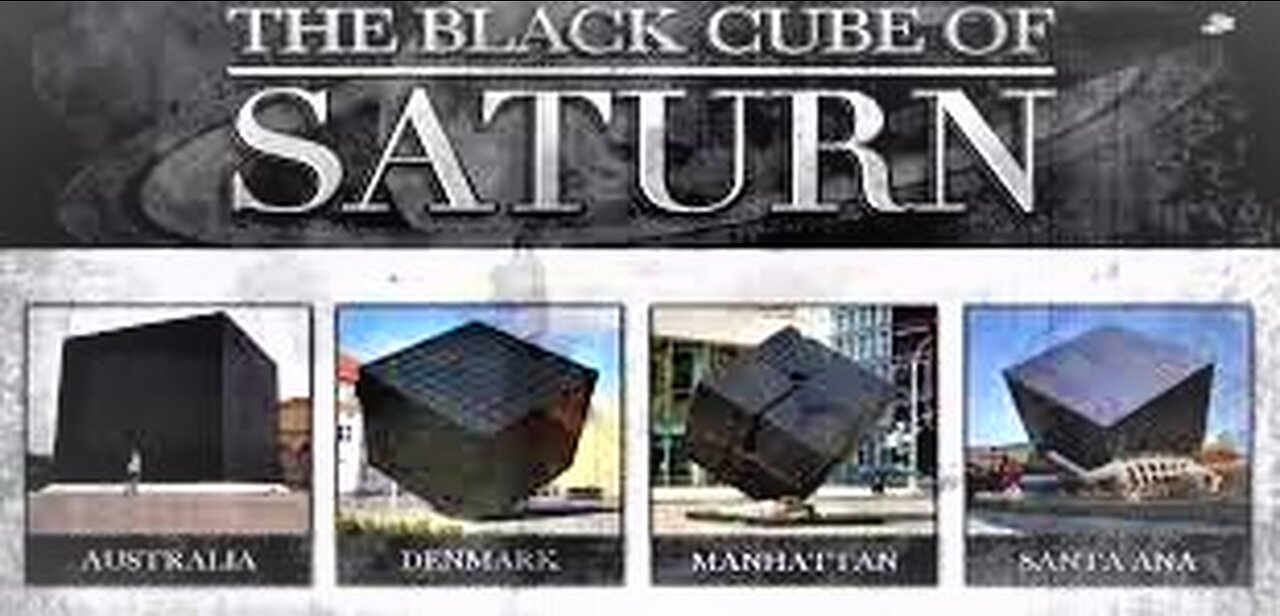Premium Only Content

Why The Jewish Worship Saturn?
Saturn, the jewel of the solar system
Israeli researchers, working with NASA, recently discovered some startling findings about the planet
https://www.cycliclaw.com/theion-publishing/the-cult-of-the-black-cube-a-saturnian-grimoire
What does the Jewish nation have in common with the sixth planet of our solar system, Saturn? While Jews are referred to as God’s chosen nation, the yellowish gas giant with its spectacular rings has also been coined as the “jewel of the Solar System.”
https://www.nicholson1968.com/nicholson1968s-post/saturn-worshipthe-black-cube
This past year, Israeli researchers stood at the forefront of new discoveries of Saturn, by using measurements coming from NASA’s Cassini probe, which self-destructed in 2017. Scientists at NASA were able to determine the age of Saturn’s rings, while Israeli researchers at the Weizmann Institute of Science in Rehovot were able to calculate that the very strong winds on Saturn are very deep, reaching some 9,000 km. into the interior of the huge planet.
These winds are much deeper than those on Jupiter, because of its lower density and weaker gravitational pull. Sounds pretty simple, right? It was anything but. The Jerusalem Report spoke to the man behind the research, Prof. Yohai Kaspi at the department of Earth and Planetary Sciences at Weizmann and head of the institute’s Center for Planetary Science about his discoveries and what makes the planet so special.
Saturn, the sixth planet from the sun, is a gaseous planet with a hot inner core. Well-recognized by its characteristic rings, its mysteries have captivated scientists for generations. In the same paper, published in the journal Science, the group determined the age of the planet’s rings after examining data from the Cassini spacecraft, concluding they are only 10 to100 million years old. In a revealing twist, that means that during the Cretaceous period – when the last dinosaurs roamed the Earth – our night sky looked vastly different than it does today.
Kaspi and staff scientist in his research group, Dr. Eli Galanti, however, focused on the planet’s airflow. “We began working on data from the Juno probe (to Jupiter) that dealt with gravity. We did this same analysis for Saturn and studied its jet-streams.” They were able to use the same ultra-accurate gravity measurements of Cassini, that was used to analyze the rings, to shed light on the stormy planet. Their research mainly focused on the jet-streams, the fast-moving air currents, which are produced by a type of internal heating of the planet.
“Most planets in the Solar System have jet-streams, including Earth. For example, if you take a flight to the US, it takes you about two more hours than when you fly back to Israel. These ‘tailwinds’ peak at about a height of 10 km. on Earth. On our planet, we only have one jet-stream per hemisphere. When we’re on an airplane, we’re flying into this wind and therefore it takes us longer. When we’re flying east, we’re carried by this wind and it takes us a shorter time. This is due in part to the rotation of the planet and the temperature difference between the equator and the poles.”
These jet-streams dominate the atmospheres, explained Kaspi. On Jupiter, there are no less than six in each hemisphere, while on Saturn, there are about four or five.
WHEN YOU look at Jupiter, one of the most startling features are the impressive color-changing bands that crisscross the planet, Saturn has them as well albeit to a lesser degree. In the late 1970s, the Voyager probe passed by Jupiter, and was able to measure, by tracking the clouds, how these white and red bands moved east and west. Since then, scientists have tried to determine if there was activity in the outer atmosphere or were the winds, in fact, penetrating deeper into the planet. All of this stands in stark contrast to our intuition, since Jupiter and Saturn lack solid surfaces – they are mainly made of gas.
The Juno and Cassini probes were able to conduct flybys very close to the planets, and measured the small accelerations of the spacecraft that were caused by movement in the planets’ atmospheres. Since density is distributed differently due to atmospheric flows, it affects the gravitational pull as well. “The flows are associated with different temperatures and densities. If the flows penetrate deep enough, then they perturb the density of the planet and affect the gravity. It’s a very small effect, but it can be measured. If you could stand on a certain place on Jupiter, you’d be about two and a half times heavier than on Earth,” explained Kaspi. Jupiter is more massive than Saturn, denser, and has a stronger gravitational pull.
Later, the researchers constructed a 3D map of the gravity field, showing where it was stronger or weaker. By doing so, the group was able to determine the depth of the fields. Separate maps were calculated for each planet.
In Saturn’s, case however, it was much more challenging, due to the presence of the rings. Saturn’s unique bands have several layers. Although there are six main rings, many objects lay interspersed between them such as moons and rocks. “In this experiment, it was like fitting a needle between the rings and the planet. The spacecraft had to go between them, in order to get an accurate reading,” Kaspi described.
He elaborated that to conduct this experiment the scientists sent a radio-beam from about a billion and a half kilometers away as the spacecraft orbits Saturn to Earth, and measured changes in the frequency of that beam as it arrived to Earth. In this manner, the team was able to probe the depth of these flows. “You’re also affected by the mass of the rings, because the rings have a mass although it’s a very thin layer, about 10 meters across,” he added.
“There is also the reflectivity of the rings,” to take into account, he noted. “The rings are made out of ice, but get covered by interstellar material similar to dust. For example, if you have a dirty car that has a lot of dust on the outside, from your own intuition, you can guess how long that car has been sitting there. It also depends on the time of year. If the car were left outside in the spring when there are plenty of dust storms, we could surmise that the car had probably been sitting there for a week. If it was in the summer, fall, or winter we would arrive at a completely different conclusion. This is a very similar methodology to how we discovered the age of the rings,” he explained. Saturn’s rings are made of pure ice. If they are “new,” they would be completely reflective.
The interstellar dust actually gives us a clue to how old they are. It was found that the rings are relatively young compared to our 4.6-billion-year-old solar system.
KASPI, ALONG with the team at Weizmann and NASA, knows that the winds on Saturn are stronger than those on Jupiter, but the teams haven’t figured out why.
“That is still an open question,” he added. “We don’t have a good answer yet.”
At the end of the Cassini mission, the probe descended into the planet and self-destructed – as per NASA’s rules – in order not to contaminate the moons of Saturn with Earth-type diseases if the probe would have been left uncontrolled orbiting within the Saturnian system. “And, who knows? You might find the coronavirus on some moon, thousands of years from now, and no one would know if it was a native version or one that came from Earth in 2020,” Kaspi quipped.
Although separated by hundreds of millions of kilometers, the two giant planets have similar compositions and properties. “Both of them are gas planets, and consist of 99% hydrogen and helium, and the rest is made up of other elements which form the clouds, like ammonia, methane, etc.,” he said. “Both of them have hot cores, so they emit heat – more or less the same heat that they receive from the sun.” Like his bigger brother, Saturn also has storms, he noted, but not permanent storms like the Great Red Spot on Jupiter. The golden planet also has bands of winds that appear on the surface like stripes. When seen through a telescope on a clear night, the planet appears bright and alternates between shades of yellow and white. The bands, however, may appear brown or yellow, depending on the airflow.
Any mission to these extremely remote planets is a unique opportunity for the scientists to explore their mysteries, but having two NASA missions at the same time was really extraordinary and actually a coincidence. “It was amazing that we had the same experiment happening at the same time,” Kaspi said, referring to data from the probes being analyzed simultaneously, “a once in a lifetime opportunity”, he added.
Unlike Earth, Saturn has around 60 moons! One of the characteristics that make the planet so unique, Kaspi explained is that some of those moons are thought to contain the ability to sustain life.
“Two of its moons, Titan and Enceladus contain a flowing liquid – or at least – subsurface oceans hidden beneath an icy surface,” he elaborated. Enceladus is an ocean world; and the probe found evidence of water spouting out from geysers near its south pole. Titan, however, is a moon that in some ways is similar to Earth.
“The most prominent characteristic of Earth’s atmosphere is that we have a water cycle,” he explained. There is liquid water in the atmosphere, as well as water vapor, and ice water. “The ability to support all those three phases is important to sustain life. We see water vapor in the clouds in our atmosphere, we see liquid water in the oceans, and ice water in glaciers and at the poles. Titan is very similar, only that its average temperature is far colder than ours on Earth. Thus, instead of a water cycle, it has a methane cycle with methane appearing as a gas, liquid, or solid.
If that isn’t the stuff of science fiction, then readers should picture this. On Titan, there is rain in the form of liquid methane, methane lakes and even methane oceans. But all this merely exists on a moon, Titan isn’t even a planet.
When asked what he believes people can achieve beyond the scope of our lifetime, Kaspi remained inquisitive.
“The biggest question I think is are we the only ones out there? Is there anybody out there?”
As an Israeli scientist at the forefront of astronomical research, Kaspi has high hopes for future joint endeavors and thinks that plenty is in store for the field. As for budding Israeli projects, he added, “They’re definitely noteworthy. Many of us, including myself, are involved in leading parts of NASA or ESA missions. Even though we’re from a small country we can still contribute. I don’t think having a space program should be a goal of a country as small as Israel, in terms of sending missions, since it’s very costly. We can certainly contribute instruments, research, and lead scientists – work such as this can be a model for how the Israeli community can be involved in space missions.” “And that is where Israel really shines.”
https://www.academia.edu/434711/Romanizing_Baal_the_art_of_Saturn_worship_in_North_Africa
The Cult of the Black Cube: A Saturnian Grimoire
€67.00
3rd Edition. 192 pages, 165×235 mm, printed on wood-free high quality Lessebo Design paper (115gsm), Surbalin metallic endpapers. Cloth Hardcover Edition, Bound in silver metallic fine cloth, front embossing, lettering on spine, headbands, book ribbon, limited to 900 copies. Theion Publishing.
Feared, bedeviled and vilified but also venerated, adored and embraced, Saturn and his shadowy powers have strongly influenced the spiritual and magical life of cultures and individuals for millennia. Concentrating especially on His antinomian and anti-cosmic character, The Cult of The Black Cube: A Saturnian Grimoire is a seminal study on the occult essence and esoteric significance of Saturn in theory and practice.
The Cult of the Black Cube: A Saturnian Grimoire is divided into three main sections:
Part I examines the ambivalent role of Saturn in various religious and magical traditions around the world focusing especially on His Islamic, Classical and Indian cults. Fleshing out the common traits underlying Saturn’s global manifestations, Dr. Moros argues for a perennial cult of Saturn expressed in various cultural guises.
Part II and III comprise the Grimoire of the Black Cube which provides a comprehensive armory of occult weaponry to initiate Saturnine contact and to establish an individual cultus of Saturn. Part II presents a thorough esoteric analysis of the Saturnine Cult and the nature of its initiatic path. Part III is devoted to the practical applications of Saturnine worship and magic.
Corrected and revised, this second edition also features a new foreword by Dr. Tomas Vincente, author of The Faceless God, and an elaborate essay by David Beth on the Saturnine deity entitled “Clavis Saturni: A Kosmic Heresy”.
David’s treatise is based on notes he had initially provided to Arthur Moros who had intended to compose a further chapter for his book detailing the Saturnian vibrations within the Kosmic ‘pandaemonic’ current – unfortunately, his premature death prevented the writing of this section. With encouragement from the Moros estate, David Beth decided to work these notes into an essay in order to make its Gnosis available to the esoteric community.
The author Dr. Moros (pseudonym) was a scholar of religions and a devoted initiate of Saturn for 30 years. Sadly he passed away in early 2017 under mysterious circumstances.
This book is his esoteric legacy.
https://www.scribd.com/document/39467442/Saturn-Worship
Occult Symbolism: Saturn Worship | PDF | Deities | Mythology - Scribd
Occult Symbolism: Saturn Worship. You might not know it, but the entire world has been worshiping Saturn for thousands of years. The cult has never stopped ...
https://www.pinterest.com/pin/326018460500223609/
Why do the elite worship Saturn? - Pinterest
Dec 1, 2014 - This is the reason that the civilizations of antiquity and their descendants in the secret societies of today worship Saturn. Saturn was/is a ...
https://www.scribd.com/document/39467442/Saturn-Worship
Occult Symbolism: Saturn Worship | PDF | Deities | Mythology - Scribd
Occult Symbolism: Saturn Worship. You might not know it, but the entire world has been worshiping Saturn for thousands of years. The cult has never stopped ...
https://forward.com/news/9794/the-sabbath-planet/
The Sabbath Planet - The Forward
Jan 5, 2007 ... Ze'ev Orzech writes from Corvallis, Ore.: “I am intrigued by the connection between the Hebrew name for the planet Saturn, shabtai, ...
https://theastrologypodcast.com/2021/07/06/ancient-jewish-views-on-astrology/
https://ew.com/celebrity/ice-cube-under-fire-tweeting-anti-semitic-images-conspiracy-theories/
-
 LIVE
LIVE
Sarah Westall
1 hour agoBlackrock & the WEF Collaborate for World Dominance, Free Agency with AI w/ Reinette Senum
211 watching -
 3:08
3:08
Michael Heaver
12 hours agoOutraged UK Sends EMPHATIC Message
1101 -
 1:20:15
1:20:15
vivafrei
3 hours agoRFK Jr. Takes on the Pharma WHOORES! Toddler-Assaulter Granted BAIL? COMPLYE WITH CRIMINALS! & more
94.6K49 -
 LIVE
LIVE
LadyDesireeMusic
2 hours ago $0.80 earnedLive Piano Request - Anti Brain Rot - Support Culture Shift
129 watching -
 LIVE
LIVE
LFA TV
10 hours agoLFA TV ALL DAY STREAM - THURSDAY 9/4/25
1,323 watching -
 13:43
13:43
The Kevin Trudeau Show Limitless
1 day agoClassified File 3 | Kevin Trudeau EXPOSES Secret Society Brainwave Training
72.8K10 -
 1:09:23
1:09:23
The HotSeat
2 hours agoTrump’s Parade = Mocked, China’s Parade = Praised: Leftist Hypocrisy EXPOSED
14.4K3 -
 1:57:29
1:57:29
The Quartering
4 hours agoRFK Jr Goes NUCLEAR, Horrible Tomb Raider News, Anti-White Male Propaganda
95K32 -
 LIVE
LIVE
Dr Disrespect
6 hours ago🔴LIVE: Hell Is Us Launch - DR DISRESPECT’s First Look at the Scariest Game of 2025!
1,042 watching -
 11:17
11:17
Dr. Nick Zyrowski
29 days agoTop 10 No CARB No SUGAR Foods That Will Change Your Health
30.4K4